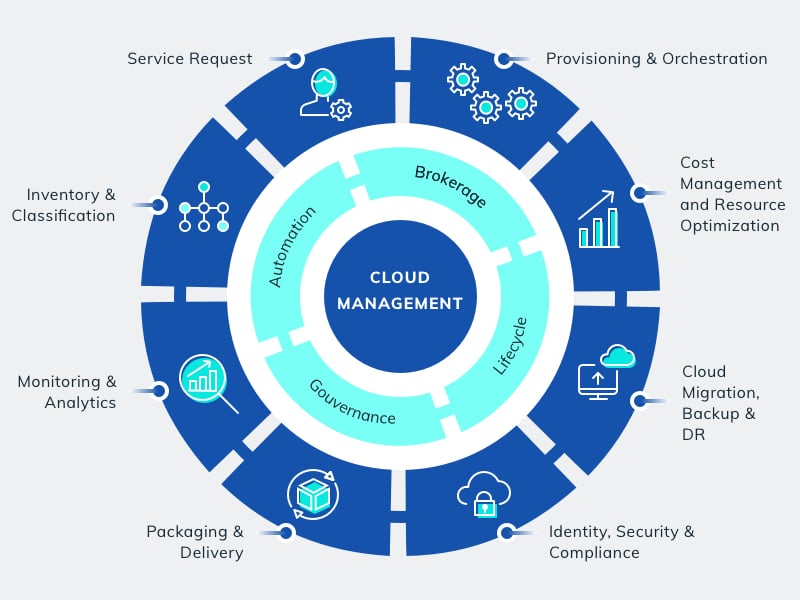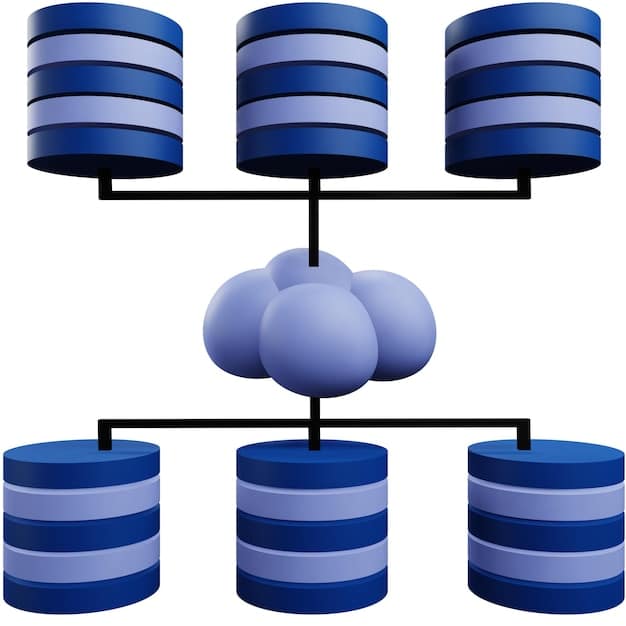Cloud Governance Frameworks: Best Practices in the US

Cloud governance frameworks are essential for US organizations to manage cloud resources effectively, ensuring compliance, security, and cost optimization through established policies, procedures, and best practices.
In today’s digital landscape, cloud computing has become a cornerstone for businesses across the United States. However, harnessing the full potential of the cloud requires a robust governance framework. This article delves into the world of cloud governance frameworks: implementing best practices in the US, offering a comprehensive guide for organizations seeking to optimize their cloud environments.
Understanding Cloud Governance Frameworks
Cloud governance frameworks are sets of policies, procedures, and responsibilities that guide an organization’s use of cloud services. It is crucial to establishing a clear structure to ensure alignment with business goals, manage risks, and maximize the benefits of cloud adoption.
Effective cloud governance is not simply about applying rules; it’s about creating a culture of accountability and collaboration across the organization. This encompasses everything from securing data and applications to managing costs and ensuring compliance with industry regulations.
Why Cloud Governance is Essential
Implementing a strong cloud governance framework is critical for several reasons. Without it, organizations can face significant challenges that can impact their bottom line and reputation.
- Cost Control: Without proper oversight, cloud costs can quickly spiral out of control. Governance helps organizations track spending, identify inefficiencies, and optimize resource allocation.
- Security and Compliance: Cloud governance ensures that security policies are consistently applied across all cloud environments, reducing the risk of data breaches and compliance violations.
- Risk Management: By establishing clear risk management processes, organizations can identify and mitigate potential threats before they impact their operations.
- Improved Efficiency: A well-defined governance framework streamlines cloud operations, making it easier for teams to collaborate and deliver value.
In conclusion, adopting cloud governance frameworks can transform a cloud environment. It goes beyond just avoiding unnecessary costs. It fortifies your defenses against sophisticated cyberattacks, helps comply with stringent legal requirements and empowers your technology teams.
Key Components of a Cloud Governance Framework
A comprehensive cloud governance framework consists of several key components working together to help to effectively manage cloud resources. Let’s examine what these are.
These components, when implemented correctly, can give organizations the ability to effectively use the cloud while mitigating potential risks.

Policy Management
Policy management is the backbone of any cloud governance framework and is something to take very seriously. It involves creating, implementing, and enforcing policies that define how cloud resources should be used. These policies should cover areas such as security, cost management, and compliance.
Effective policy management ensures consistency and reduces the risk of errors or violations. Automated policy enforcement can help to streamline this process and ensure that policies are consistently applied across all cloud environments.
Identity and Access Management (IAM)
IAM is critical for securing cloud resources and ensuring that only authorized users have access to sensitive data. IAM solutions should provide features such as multi-factor authentication, role-based access control, and privileged access management.
Proper IAM implementation helps organizations to prevent unauthorized access, reduce the risk of insider threats, and comply with regulatory requirements.
- Centralized Identity Management: A single source of truth for user identities.
- Multi-Factor Authentication (MFA): Adding an extra layer of security.
- Role-Based Access Control (RBAC): Assigning permissions based on job roles.
Adopting IAM is a pivotal way to secure data and control access to it. For instance, centralized identity management makes it simpler to handle user accounts and permissions across various platforms. Additionally, applying Multi-Factor Authentication (MFA) improves protection against unauthorized entry.
In summary, a cloud governance architecture should not only concentrate on IAM but integrate it inseparably as a component within its structure. When these pieces are aligned and optimized, businesses can improve their security posture, optimize workflows and fully accept cloud computing potential.
Implementing Governance Policies in the US
Implementing effective governance policies in the US requires a tailored approach that considers the specific regulatory landscape and industry best practices. US organizations must adhere to a variety of federal and state regulations, such as HIPAA, PCI DSS, and GDPR (if processing EU citizens’ data).
The implementation process should involve collaboration between stakeholders from different departments, including IT, security, legal, and compliance. This helps to ensure that policies are comprehensive and aligned with business objectives.
Compliance with US Regulations
Compliance is a critical aspect of cloud governance in the US. Organizations must understand the regulatory requirements that apply to their industry and ensure that their cloud environments are configured to meet those requirements.
Tools such as compliance dashboards can help to monitor compliance status and identify potential violations. Regular audits and assessments can also help to ensure ongoing compliance.
Best Practices for Policy Enforcement
Effective policy enforcement requires a combination of technical controls, training, and communication. Policies should be clearly documented and communicated to all employees. Technical controls, such as automated policy enforcement, can help to ensure that policies are consistently applied.
- Automated Policy Enforcement: Using tools to automatically enforce policies.
- Regular Training: Educating employees about policies and best practices.
- Clear Communication: Ensuring that all employees understand the policies.
Effective governance policies are not static; they should be continuously reviewed and updated to address new threats and regulatory changes. This ensures that the organization remains protected and compliant over time.
To sum up, implementing sound governance policies in the IT arena requires a custom strategy considering both rules and industry accepted practices. For businesses to conform with the requirements of their industries, compliance monitoring technologies as well as standardized audits are obligatory.
Choosing the Right Cloud Governance Framework
Selecting the appropriate cloud governance framework is an essential step in setting up a good cloud governance foundation. The best framework should be well-matched to the organization’s specifications, aims, and level of cloud adoption.
There are several frameworks to choose from, each with its strengths and weaknesses. It’s important to carefully evaluate each option to determine which one is the best fit.

Common Cloud Governance Frameworks
Several cloud governance frameworks are available, each offering a unique approach to managing cloud resources. Let’s explore some popular options.
- COBIT: A comprehensive framework for IT governance and management.
- ITIL: A set of best practices for IT service management.
- NIST Cybersecurity Framework: A framework for managing cybersecurity risks.
Factors to Consider When Choosing a Framework
When selecting a cloud governance framework, several factors should be taken into account. These include the organization’s size, industry, regulatory requirements, and cloud maturity level.
- Scalability: The ability to scale the framework as the organization grows.
- Flexibility: The ability to customize the framework to meet specific needs.
- Cost: The cost of implementing and maintaining the framework.
Picking the right cloud governance framework necessitates thorough consideration of various components, for instance the level of modification allowed, scalability and its expense. Ensuring proper governance practices is a continuous activity.
In summary, a well-structured design allows for constant modifications which guarantees that firms can successfully meet the developing intricacies related to cloud operations as they expand.
Tools and Technologies for Cloud Governance
To successfully implement cloud governance frameworks, organizations can leverage a variety of tools and technologies. These tools automate tasks, provide visibility into cloud environments, and help to enforce policies.
These technologies support security and compliance activities, making it easier for organizations to proactively manage risk and achieve their business goals.
Cloud Management Platforms (CMPs)
CMPs offer a centralized console for managing cloud resources across multiple cloud environments. They provide features such as resource provisioning, cost management, and performance monitoring.
CMPs can help to streamline cloud operations, improve efficiency, and reduce costs. They also provide visibility into cloud usage, making it easier to track spending and identify inefficiencies.
Security Information and Event Management (SIEM)
SIEM solutions collect and analyze security logs from across the cloud environment. They help to identify and respond to security threats in real-time.
By leveraging SIEM, organizations can improve their security posture, reduce the risk of data breaches, and comply with regulatory requirements.
- Real-Time Monitoring: Continuous monitoring of security events.
- Threat Detection: Identifying potential security threats.
- Incident Response: Responding to security incidents quickly and effectively.
Cloud governance involves a continuous process of refining strategies and optimizing resources to stay in step with business goals and technological changes. This adaptability enhances cloud investments as well helping to avoid potential difficulties that may emerge from a careless cloud adoption strategy.
Ultimately, integrating the right instruments as well as methodologies guarantees that organizations capitalize on cloud opportunities by mitigating potential hazards effectively.
Measuring the Success of Cloud Governance
After a cloud governance framework is implemented, it’s essential to measure its effectiveness. This helps to identify areas for improvement and ensure that the framework is delivering the desired results.
By continuously monitoring and evaluating the cloud governance framework, organizations can ensure that it remains effective and aligned with business objectives.
Key Performance Indicators (KPIs)
KPIs provide a way to track progress towards specific goals. Common KPIs for cloud governance include:
- Cost Savings: Measuring the reduction in cloud costs.
- Security Incidents: Tracking the number of security incidents.
- Compliance Violations: Monitoring compliance with regulatory requirements.
Measuring the success of cloud governance is crucial for organizations to assess the effectiveness of their strategies and make informed decisions.
Regular Audits and Assessments
Regular audits and assessments can help to identify gaps in the cloud governance framework and ensure that it is being followed consistently.
These audits should be conducted by independent third parties to ensure objectivity. The results of the audits should be used to improve the cloud governance framework and address any identified weaknesses.
In summary, regular audits and reviews of cloud deployments ensure adherence to the set protocols. Therefore, businesses are well placed to manage costs, reduce possible risks and secure information assets inside their virtual infrastructure when they make proper strategic amendments to their cloud environments.
| Key Point | Brief Description |
|---|---|
| 🛡️ Policy Management | Creating and enforcing policies for cloud resource usage. |
| 🔑 IAM | Managing access control to secure cloud resources. |
| 💰 Cost Control | Tracking and optimizing cloud spending. |
| ✅ Compliance | Ensuring adherence to US industry regulations. |
FAQ
▼
A cloud governance framework is a set of policies, procedures, and responsibilities that guide an organization’s use of cloud services. It helps manage risks and ensures alignment with business goals.
▼
Cloud governance is crucial for US organizations to ensure compliance with regulations like HIPAA and PCI DSS, manage costs, and secure sensitive data in the cloud.
▼
Key components include policy management, identity and access management (IAM), cost management, security and compliance, and risk management which work together in harmony.
▼
Organizations can measure success through KPIs like cost savings, reduced security incidents, compliance adherence, and improved operational efficiency in the cloud.
▼
Popular tools include Cloud Management Platforms (CMPs) for resource management, Security Information and Event Management (SIEM) for threat detection and tools related to compliance and risk management.
Conclusion
Implementing robust cloud governance frameworks: implementing best practices in the US is essential for US organizations looking to maximize the benefits of cloud computing. By establishing clear policies, procedures, and responsibilities, organizations can ensure that their cloud environments are secure, compliant, and cost-effective. Embracing cloud governance is not just a best practice; it’s a strategic imperative for sustained success in the cloud.





